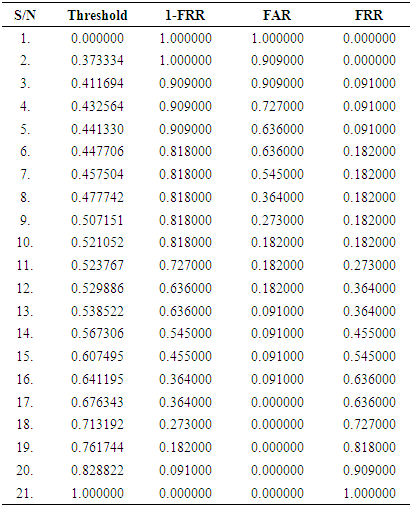-
Paper Information
- Paper Submission
-
Journal Information
- About This Journal
- Editorial Board
- Current Issue
- Archive
- Author Guidelines
- Contact Us
American Journal of Signal Processing
p-ISSN: 2165-9354 e-ISSN: 2165-9362
2017; 7(1): 25-37
doi:10.5923/j.ajsp.20170701.03

Development of a Multimodal Biometric Model for Population Census
T. F. Owuye1, I. O. Awoyelu1, S. O. Bamiwuye2
1Department of Computer Science and Engineering, Obafemi Awolowo University, Ile-Ife, Nigeria
2Department of Demography and Statistics, Obafemi Awolowo University, Ile-Ife, Nigeria
Correspondence to: T. F. Owuye, Department of Computer Science and Engineering, Obafemi Awolowo University, Ile-Ife, Nigeria.
| Email: |  |
Copyright © 2017 Scientific & Academic Publishing. All Rights Reserved.
This work is licensed under the Creative Commons Attribution International License (CC BY).
http://creativecommons.org/licenses/by/4.0/

Population census plays a vital role in human’s well-being as well as in a nation’s development. It is an enumerative technique that provides answers to how, who and where. In years past, several techniques have been adopted to address the problem of multiple-count during population census. However, the problem still lingers and culminate into rejection of some of the results thereby negating the purpose of census. These lead to proposing a multimodal biometric approach to conducting population census in this paper. This work aimed at developing a multimodal biometric model capable of uniquely distinguishing each enumerated person in census by combining iris, face and demographic data of same individual. A post-match technique of multimodal fusion was adopted for tracking multiplicity in this work. The proposed model was evaluated based on set of thresholds using FAR, FRR and EER as performance metrics. The results obtained showed that the proposed model gave an EER of 0.18%. The single-modal model of iris had EER of 0.44% and face had EER of 0.19%. This implies that the multimodal model integrating iris and face outperforms the single-modal model of iris and single-modal model of face by 59.09% and 5.26% respectively. The study concludes that the proposed model contributes to existing works on population census by integrating iris and face multimodal biometric to optimally minimize multiple-count in census thereby providing accurate figure acceptable by the populace.
Keywords: Population census, Enumeration, Multimodal biometric, Multiple count, Post-match
Cite this paper: T. F. Owuye, I. O. Awoyelu, S. O. Bamiwuye, Development of a Multimodal Biometric Model for Population Census, American Journal of Signal Processing, Vol. 7 No. 1, 2017, pp. 25-37. doi: 10.5923/j.ajsp.20170701.03.
Article Outline
1. Introduction
- Planning is highly important to attain success in any country. It is always said that failure to plan is to plan to fail. This can be linked to the main reason for conducting population census in any given country. When a nation does not know the proportion and the total number of its citizens, its planning process is likely to be distorted [12]. Individual country needs to know her population size, distribution and characteristics to effectively plan its economy, judiciously use its relatively scarce resources and adequately cater for its populace. Population can be defined as the total number of people living in a country at a given period. Census is a periodic and deliberate head-count of all residents in a country over a period [1], each individual country need an accurate and accepted census data to plan for virtually everything [29]. It is unfortunate to note that Nigeria does not have authentic census data in this 21st century [12]. In order to provide finance, efficient security, stable power supply, good roads, standard education, effective health facility and other social amenities; Nigerian government must know the figure of its populace. Population size aids in determining the ratio of the densely-populated region to the fewer regions. Information must be collected about each person living in a country to determine the reality that such individual exists; this information is further used to meet the need of the populace. A detailed population count helps to analyze and understand problems emanating from different areas within a country and proffers reasonable solution to such problems. Population census in Nigeria is undoubtedly an important issue of concern since population in terms of its size and composition has far-reaching implications for change, development and quality of life in society [12]. Even in the face of the wide-spread controversies that travail each census in the Third World Countries, there is no running away from the clear fact that census remains a versatile source of information about a nation [3].Data accumulated from several censuses helps countries to evaluate the past, describe the present and forecast the future [22]. An accurate census data helps to build a solid foundation for a sustainable and prosperous future. Most of the developing countries are faced with problems of accurate census data and such problems are encountered during data collection [7]. Population census is an enumerative technique that provides answers to the number of citizen; the personality of such citizen; and the living condition of the citizen living in a country at a given time [12]. In Nigeria, population census experience has shown persistent and difficult pattern of error in the data collection and analysis [24]. The sources of errors encountered in census can be grouped into two [33]. These are coverage and content errors. Coverage errors are errors which arise from duplicity or multiplicity of individual’s. Most common error encountered in census is coverage error. Content errors refer to the accuracy of information collected about an enumerated individual. The economic development in Nigeria would have been much easier if reliable population data were available because the absence of authentic population data directly affects government’s inability to ensure balanced political representation and equal access to important governmental resources by all regions [4]. Several methods used interchangeably for past census enumerations in Nigeria had been reviewed and the conclusion is that none had been able to provide an accurate census result [9]. The allegations of over count had continued to trail census results and this has made planning for development unrealizable and unrealistic.Looking at the past population census in Nigeria both before and after independence, it has always ended in national controversy and strong allegations of falsification [4]. The inflation of census figures amongst Nigerian states does not seems to disappear soon as it is geared towards obtaining the advantages accruing from having higher population figures in the country. The dearth of accurate and credible statistical data has been a serious handicap to the economic and political development of Nigeria and the future censuses in Nigeria is not likely to produce an expected and credible data that can be used for effective planning without adopting an improved and secured technology [12]. The importance of population census to the advancement of any country’s economy has been established and it is inseparable as it serves as a foundation to any country’s development and survival. There is no doubt that a technology capable of producing authentic and acceptable census data is justifiably needed for countries to judiciously plan and boast their various economies. This can only be achieved by introducing a robust technique capable of distinguishing each enumerated individual and guard against such as multiple-enrollment of persons. The existing approaches to security management by various agencies and sectors focused on the use of possession (card, token) and knowledge-based (password, username) strategies which are susceptible to forgery and other activities of fraudsters [15]. To overcome this shortcoming, the use of human metrics for recognition should be embraced. Sequel to the state of earth in the literature on population census, this work aimed at developing a multimodal biometric approach to census. A biometric technology helps to detect individuals who may attempt to compromise the process of enumeration by presenting for re-count in different areas mapped for census. Biometric is defined as human recognition based on physical or behavioral traits [6]. It can be grouped into two categories based on its application. It is namely, the verification and identification mode. In verification mode (authentication), the biometric information of individuals who claims a certain identity is compared with his own biometric template stored in the system database usually called a one to one comparison (1:1). In identification mode, the system identifies an individual by searching the templates of all the individuals whose templates are stored in the database. This is a one to many (1: n) comparisons. Biometrics system of recognition is usually of two different modes namely single-modal systems and multimodal systems. Single-modal system uses only one trait for recognition, however, close to 8% of people cannot use it due to the problem of non-universality [18]. Single-modal biometric is not usually accurate for authenticating large population. Each single-mode biometric technology has its strengths and limitations, and no single biometric is expected to effectively satisfy the requirements of all verification or identification applications [17].Multimodal system combines more than one trait for recognition. A multimodal system uses more than one trait so that any abnormality in one trait can be overcome by the other. For example, in Nigeria, there are individuals who lack certain human features such as palm, fingerprint, legs and so on; this individual are still living despite their deformity. Such individual will benefit so much from the adoption of multimodal biometric for recognition in census.Multimodal biometric systems have not been used in most organizations especially those assigned to capture all citizens; no provision for those lacking fingers or any other features so that all eligible citizen can be enumerated without difference [11]. The objectives of this paper are to formulate a multimodal biometric model for population census, simulate the model and to evaluate the performance of the model. Section 2 lists existing works around population census and biometric. Section 3 describes the experimental methods used in carrying out this study with the model formulation and simulation. Section 4 reports the result of the evaluation and section 5 presents the conclusion of the work.
2. Existing Work on Population Census and Multimodal Biometrics
- Several works have been carried out in population census and multimodal biometric. There are various scenarios that are possible in multimodal biometric systems using fingerprint, face and iris features, the different level of fusion that are possible and the integration strategies that can be adopted to combine information and improve overall system accuracy [17]. It is further stated that for larger user population systems having more than tens or hundreds of millions of subject images already enrolled in the matcher databases and equally must process more than hundreds of thousands of requests; such system’s identification accuracy is highly important.A description of data processing method adopted for Nigeria’s 2006 census exercise was conducted [13]. The 2006 population count was the last conducted in Nigeria. Scanning technology was fully deployed in the data processing. After the census, forms (questionnaires) used to collect data were received at designated data processing centers (DPC). The forms were scanned into the computer systems to record enumerated individual’s representation in the census database. From this method, tendency of filling separate form for an individual is possible. A census data collection system was designed and implemented [35]. A client tool with personal digital assistant (PDA) device was used. The device has a census application which is used to collect information about individuals. The use of only personal digital assistant (PDA) device for authentication cannot justify the overall outcome of a population census as people may represent themselves at different enumeration centers across the country and supply irregular bio-data for inflating results of regions.Biometric approach to population census conduct and national identification in Nigeria was proposed [4]. The paper analyzed the importance of statistical knowledge of Nigeria’s population in terms of planning and development. It suggested and buttressed the significance of biometric system for data collection during census. A biometric system for data collection was suggested for carrying out population count; however, the paper only presents an overview of population census conduct in Nigeria and suggests biometric approach to having an authentic and trustworthy census data. Furthermore, a two-modal biometric system efficient for authenticating persons and eliminating possibility of double registration was conducted [21]. The author combined face and fingerprint characteristics of individual. Fusion at feature extraction level was adopted in this work. Fusion before match is the act of integrating multiple templates before subjecting the template to the matcher engine which implies that if two different individuals has the same fusion value, then the system fails to accept subsequent fusion values. Over the years, several techniques have been adopted to address the problem of multiple count during census. However, the problem still lingers and culminate into rejection of some of the results thereby negating the purpose of census. The need for a model that uniquely identify enumerated individual arises; hence this study. The proposed work focused on optimally reducing multiple counts during census enumeration. The work adopted a fusion after match technique. In Nigeria, the fear of subjecting fingerprints for recognition by individuals has been noted to be a challenge during biometric enrollment. As people are afraid of contacting disease via the scanner as lots of individual are enrolled via a single fingerprint scanner serially without the surface of the machine being cleaned. Some people may feel offended about placing their fingers on the same place where other people have touched while some people are observed to have damaged fingerprint surface [2]. The Ebola virus was introduced into Nigeria on 20 July 2014. A Liberian man infected by the epidemic of Ebola virus disease (commonly known as "Ebola") arrived by airplane into Lagos which is the Africa's most populous city. The man died in the hospital five days later, after he had set off a chain of transmission. Ebola virus is spread through direct contact with the body fluids (including but not limited to sweat) of a person who is sick with it [8]. This implies that any affected Ebola patient with damaged fingerprint has possibility of transmitting the virus to subsequent enrolled individual with (or without) damaged fingerprint. The critical examination of the shortcomings observed during fingerprint enrollment in Nigeria with other existing facts lead to the selection of iris and face biometrics for this research as the two features do not require enumerator-to-individual body contact. This will also help in overcoming difficulties in enrolling some aged individuals who find it difficult placing their fingers aright on fingerprint scanners at the point of capture. It was assumed that all human possesses facial appearance however the look. It was equally observed that application of facial make-up, hair weave-on, hair-cut, eye glass, heavy jewelries and forged tribal marks may change the look of a person. If a person who has no finger can alter his or her facial look from the initial capture, such person might be counted more than once. These lead to selection of a physical feature with biological feature for multiplicity removal unlike combining fingerprint and face physical feature [21].Some advantages have been sighted with the use of iris as biometric identification [19, 25]. Iris is said to be an internal organ that is well protected against damage and wear by a highly transparent and sensitive membrane (the cornea) and this distinguishes it from fingerprints which can be difficult to recognize after years of certain types of manual labor. Iris has a fine texture that-like fingerprints-is determined randomly during embryonic gestation. In addition, genetically identical individuals have completely independent iris textures, whereas DNA (genetic "fingerprinting") is not unique for about 0.2% of the human population who have a genetically identical twin. Iris has shown good accuracies in multiple large scale deployments [17]. Iris is reliable due to its uniqueness and stability [10]. Iris recognition is the most accurate and reliable biometric identification system available among other biometrics technique because even the both iris of same individual is different [32]. Iris part consist of patterns desired for authenticating persons [34]. The texture of iris is very complex, which carries lots of different information that can be used for identity recognition and it is formed during embryonic and becomes stable after two years [36]. Iris scan uses high resolution digital camera usually illuminated with light. Face is recorded as the most popular biometric modality used by humans [31]. The general overview of the proposed model is presented in Figure 1. The process commenced with loading of both iris and face images, the images are preprocessed and passed to the feature extraction engine. The images were converted to gray images (. pgm) using IrfanView. It was the first window graphic viewer worldwide with multiple-GIF Support. Normalization was done to remove the abnormalities e.g. noise. Resizing of the image was carried out to attain equal dimensionality for managing variations. Principal component analysis was used to locate the region of interest in the face while iris localization was done. Facial features were extracted and decomposed into uncorrelated and orthogonal components known as eigen face. The extracted templates were passed to the matching module, which takes the extracted templates as input and compares it to stored templates. Templates are numerical representations of key points taken from human's body used to identify individuals. The result is a match score, which is further used by the decision module to decide (using a set threshold to determine) whether the presented samples match is new or existing in the stored template. Identification mode was employed in searching a similar template in the databases. The output of the decision is a binary match or non-match. The weighted sum average of the existing matching template was computed and distance compared to the threshold. A combination approach can be described as a situation where the individual matching scores are combined into a single score for decision making [30]. Combinational approach was used in this work. The accepted binary match from the iris module and face module was combined with the demographic data and passed as a single entity for representation in the census database. Score normalization was carried out to transform the scores of the individual matchers into same length.
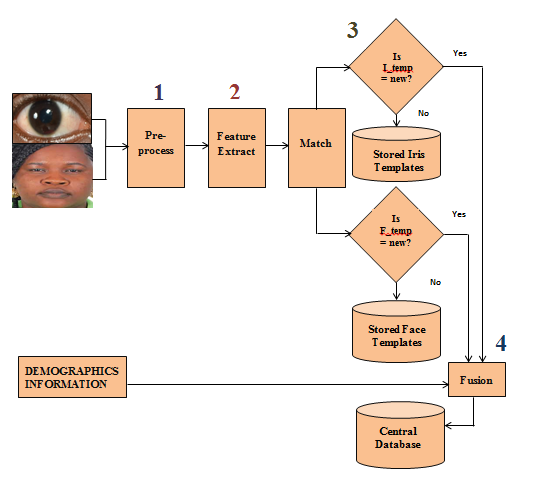 | Figure 1. Proposed Model |
3. Methodology
3.1. Data Collection
- In this study, a total number of one hundred and twenty 120 datasets of face and iris was used. Forty (40) templates were used for matching while sixty (60) templates were used for training. A duplicate of stored templates was generated to test the performance of the system. A high definition image capture device was used to collect iris images while digital camera was used to collect facial images. Primary data was used for this work. The images were captured with a white background and in jpeg format.
3.2. Model Formulation
- One of the objectives of this study is to formulate a multimodal biometric model. In this paper, Galton theory was used for the model formulation. As an investigator of the human mind, Francis Galton founded psychometrics (the science of measuring mental faculties) and anthropometry. Anthropometric measurements are used to assess the size, shape and composition of the human body. The model formulation for this study integrates iris and face of same individual with bio-data of such individual. In formulating the model, “OR” rule was applied where each enumerated person can be verified using either iris or face modality.Let
 denotes a given multimodal biometric model having I as iris recognition system, F as face recognition system and
denotes a given multimodal biometric model having I as iris recognition system, F as face recognition system and  as demographic data.
as demographic data.  is as stated in Equation 1.
is as stated in Equation 1.  | (1) |
3.2.1. Iris Biometric Model
- The iris single-modal model, I, gives the hamming distance (HD) between new iris image and the stored iris template(s) for the existing images k = 1, 2, 3, 4, …n in the iris database. Thus, I can be represented by discrete function, as shown in Equation 2.
 | (2) |
3.2.2. Face Biometric Model
- The face single-modal model, F, gives the Euclidean distance between a new face image and eigen-face template(s) for the existing k = 1, 2, 3, 4, …. n in the face database as represented in Equation 3. Thus, F can be represented by similarity function as shown in Equation 3.
 | (3) |
3.2.3. Demographic Data
- These are data about enumerated individuals. The demographic data also called bio-data enlists data such as title, surname, other names, email, mobile number, gender, marital status, age range, state of origin, local government area, occupation, nationality, place of birth, date of birth, residential address, educational qualification, location during census, religion and identity number. It is denoted as
 for existing i = 1, 2, 3, 4……. n of individuals.Therefore, the proposed multimodal biometric model combining iris, face and demographic data can be denoted as stated in Equation 4.
for existing i = 1, 2, 3, 4……. n of individuals.Therefore, the proposed multimodal biometric model combining iris, face and demographic data can be denoted as stated in Equation 4. | (4) |
3.3. Model Simulation
- The multimodal biometric model for population census was simulated using MATLAB 8.1.0.604 (R2013a) environment. MATLAB functions were written and run to implement the biometric based multimodal census model. MATLAB is a proprietary product of Math Works incorporation. It is a high-performance language used for technical computing. It integrates computations, visualization and programming in an easy environment where problems and solutions are expressed in familiar mathematical notation and terms. Simulation was carried out based on one hundred respondents, while 20 sample values were used for validation and evaluation to check multiple matches.Figure 2 represents the iris biometric module for new template while Figure 3 represents the iris biometric module for multiple templates. The iris single-modal module segment and calculate mean average based on existing images in the iris database. Furthermore, Hamming distance was employed to determine the degree of dissimilarity between the new and existing template. The face single-modal module was subjected to processes such as feature extraction for obtaining binary image, eigen face was derived and euclidean distance calculated to ascertain the authenticity of template. Figure 4 and Figure 5 represent the face module for the new enrollment and multiple enrollments. Figure 6 shows the interface of the proposed multimodal biometric model for population census. The module loads the iris, face and demographic information of same enrolled individual and generate the resulting fusion value which serve as the individual system identification value. This value is unique to every enumerated individual as no two individuals can possess same iris, face and demographic information.
 | Figure 2. Module for Newly Enroll Iris |
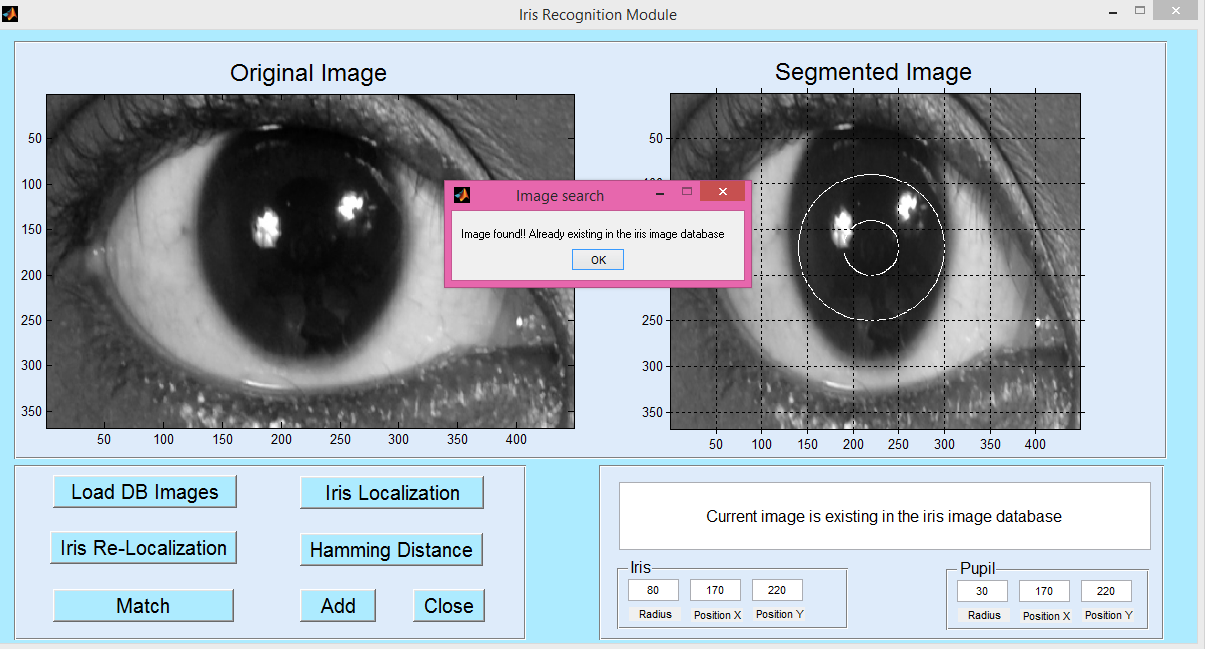 | Figure 3. Module for Multiple Enroll Iris Template |
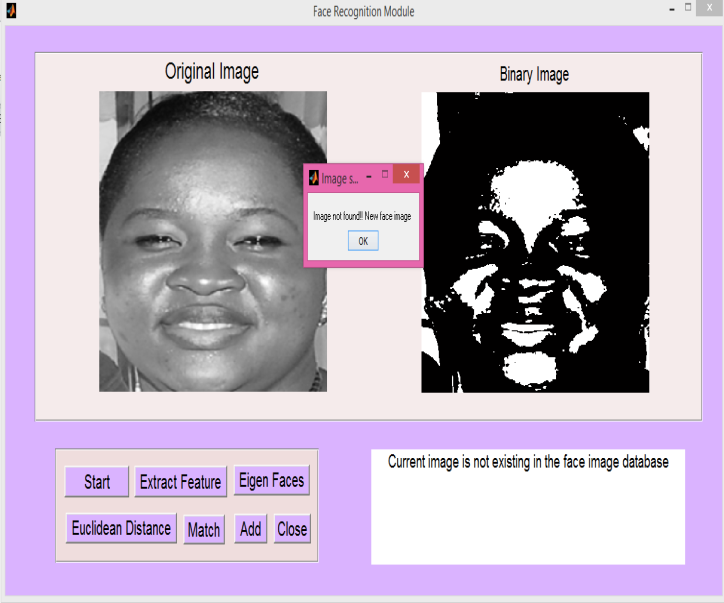 | Figure 4. Module for Newly Enroll Face Template |
 | Figure 5. Module for Multiple Enroll Face Template |
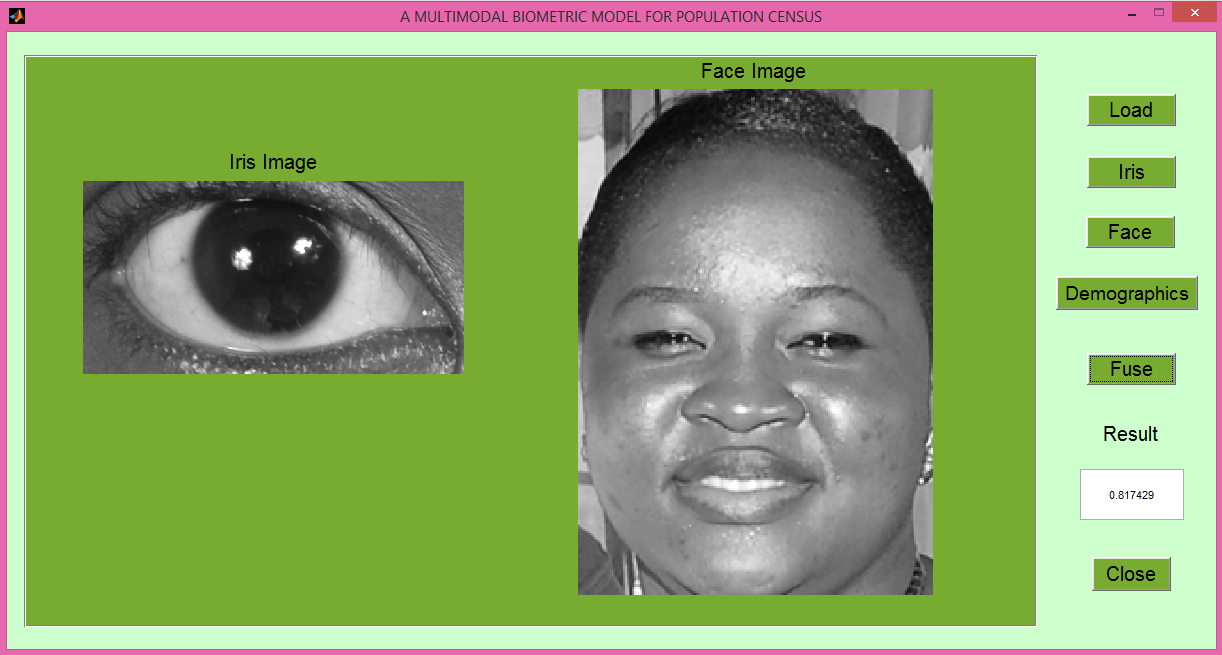 | Figure 6. Module for Multimodal Biometric Model for Population Census |
4. Results
4.1. Performance Evaluation
- Evaluation helps to ascertain the effectiveness, efficiency and accuracy of models. Certain scores (weights) are usually used to express the similarity between a pattern and a biometric template. The higher the score, the higher the similarity between the template’s. Access to the system is granted only, if the score for a trained person or the person that the pattern is verified against is higher than a certain threshold. The goal of every multimodal biometric system is to reduce one or more of false accept rate (FAR), false reject rate (FRR) and equal error rate (EER). The proposed model was evaluated using three performance metrics i.e. false acceptance rate (FAR) and false rejection rate (FRR) and equal error rate (EER). False acceptance rate is also called a type II error. FAR helps to determine the accuracy level of a biometric system. It is the mistake occasionally made by biometric systems. In an instance of false acceptance, an unauthorized person is identified as an authorized person. False rejection rate (FRR) is also called a type I error. FRR is the instance of a security system failing to verify or identify an authorized person; it is occasionally made by biometric systems. In an instance of false rejection, the system fails to recognize an authorized person and rejects that person as an impostor. However equal error rate (EER) is achieved when the score distributions overlap i.e. the FAR and FRR intersect at a certain point and the lower the EER, the better it is for the system's performance, as the total error rate which is the sum of FAR and FRR at the point of EER decreases. The matching algorithm uses a threshold which determines how close to a template the input must be for it to be considered a match. This threshold value is in some cases refers to sensitivity, it is marked on the X axis of the plot. When the threshold is reduced, there will be more false accept errors (high FAR) and less false reject errors (low FRR); a higher threshold will lead to lower FAR and higher FRR. EER is the point at which FRR equals FAR and it is considered the most important measure of biometric systems accuracy. The iris single-modal model gave an equal error rate (EER) of 0.44% as in Figure 7 while face single-modal model gave 0.19% as depicted in Figure 8. A minimum EER is 0.18% is attained for iris-face multimodal model as shown in Figure 9 compared to the single-modal case of iris and face model. Accuracy is the most important factor of a biometric identifying verification system. If the system cannot accurately separate authentic persons from impostors, it should not even be termed a biometric system. Threshold is a value, predefined by the system administrator which is used to decide the authenticity of a person as shown in Equation 6; and it goes in hand with false rejection rate and false acceptance rate in a biometric system.
 | (5) |
 | Figure 7. Equal error rate (EER) for Iris Single-modal Model |
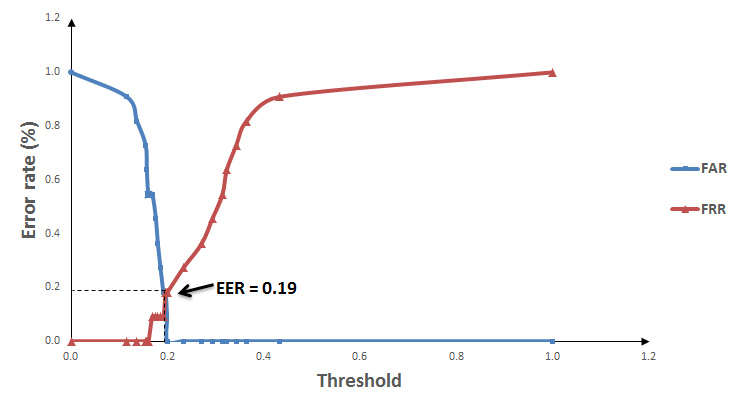 | Figure 8. Equal error rate (EER) for Face Single-modal Model |
 | Figure 9. Equal error rate (EER) for Iris-face Multimodal Model |
4.2. Data Description
- Face width was resized to 92 by 4 while the height was resized to 112 by 4 and saved as a portable gray image (. pgm) extension. The images are measured in pixels. Table 1 shows some of the enumerated images with corresponding multimodal value. It can be observed from image_444 and image_666, that same fusion value was recorded except the demographic data; this is one of the significant of this work compared to technique of fusing before matching as mentioned earlier. Considering a situation where fusion is done before match, the iris single-modal value and face single-modal value will be indeterminate. From Table 1, images with serial number (S/N) 1 to 10 are initial images subjected to enrollment while images from serial number (S/N) 11 to 20 are replicate image from the initial enrollment. This process was carried out to test the accuracy of the system. It can be seen that I value for replicate images (S/N 10 to 20) is higher than I value for real images (S/N 1 to 10). For example, I value for Image_3 is lower than that of Image_333 and Image_27 is lower than Image_277 etc. Also for F value, real images (S/N 1 to 10) are higher than replicate images (S/N 10 to 20). These implies that as F approach “0”, it signifies multiple persons’ enumeration while as I approach “0”, it signifies different persons’ enumeration. This makes I and F are inversely related.
|
|
4.3. Result Discussion
- It can be deduced that the equal error rate (EER) for the score-level fusion of iris-face multimodal biometric model is reduced compared to equal error rate (EER) of single modal of iris and face model. The proposed multimodal model outperforms a single-modal biometric model of iris and face by 59.09% and 5.26% respectively. The receiver operating characteristic (ROC) curve is created by plotting sensitivity against 1-specificity at various threshold settings. Figure 10 represents the ROC curve for the iris single-modal biometric model while Figure 11 represents the ROC curve for face single-modal biometric model and Figure 12 represents the ROC curve for iris-face multimodal model. An increase in sensitivity is accompanied by a decrease in specificity and the closer the curve follows the left-hand border and the top border of the ROC space; the more accurate the test is while the closer the curve to the 45-degree diagonal of the ROC space, the less accurate it becomes. Any increase in sensitivity is accompanied by a decrease in specificity. The closer the curve follows the left-hand border and then the top border of the receiver operating curve (ROC), the more accurate the test becomes while the closer the curve to the downward right the diagonal of the ROC space, the less accurate it becomes. However, this study records 80% accuracy for iris single-modal model, 92% accuracy for face single-modal model and 84% for iris-face multimodal model. Therefore, iris can be categorized as “sufficient” condition while face as “necessary” condition.
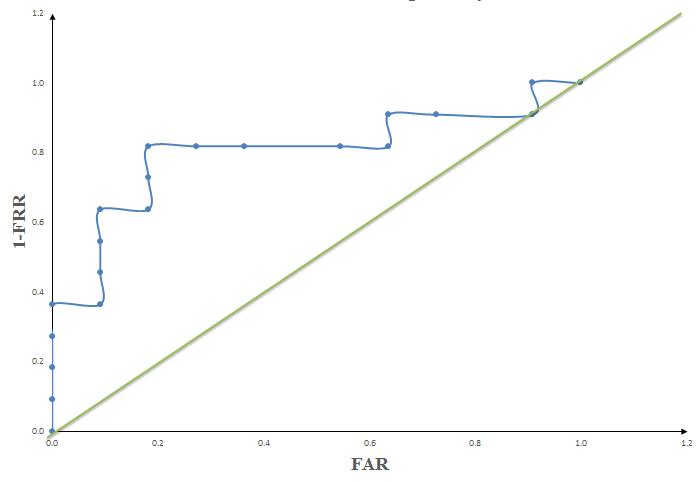 | Figure 10. ROC Curve for Iris Single-modal Model |
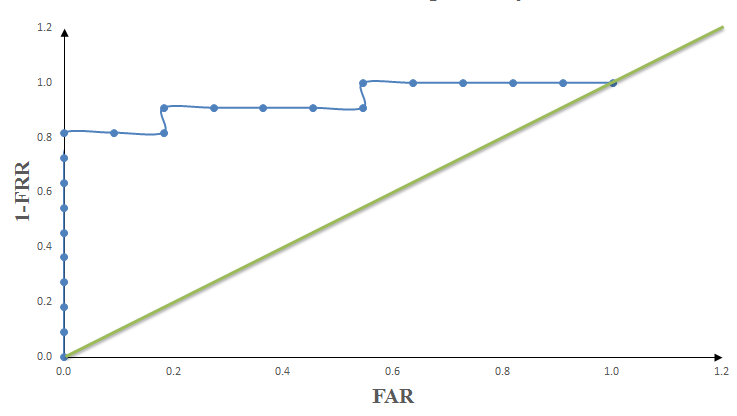 | Figure 11. ROC Curve for Face Single-modal Model |
 | Figure 12. ROC Curve for Iris-face Multimodal Model |
5. Conclusions and Recommendations
- As basis for revenue allocation and allocation of scarce resources, census has always generated different forms of controversies, ethnic antagonism and politization. This led to states struggling towards inflation of census figures to gain numerical strength through enumerators conducting multiple counts of individuals. It is in this regard that this research was conducted. The proposed multimodal biometric model has contributed to existing works on population census by integrating iris and face multimodal biometric to distinguish enumerated persons. The work is unique as it can be used in any government database to remove multiple individuals or ghost representation. It is suggested that further research work be directed towards addressing content errors during population census exercise.
ACKNOWLEDGEMENTS
- I appreciate all individuals who assisted in collecting data for this work. Your input made this research a reality.My profound gratitude goes to, Prof. A. Salami, Prof. and Mrs. F. O. I. Asubiojo, Prof. and Mrs. C. Obafemi, Prof. K. T. Taiwo and Prof. S. Ajayi; for your parental support. Your words of advice kept me while this research lasted. To Dr. A. O. Ajayi; I thank you for your professional guidance towards achieving huge success of this work. To my father; Prince S. A. Owuye you remain my pillar. Thanks for your words of encouragement. The Lord bless and make his face shine on you.Finally, Ayobami Olasoji accept my deepest gratitude. Indeed, you are a brother, thank you for building confidence and hope in me when the times got tough.
 Abstract
Abstract Reference
Reference Full-Text PDF
Full-Text PDF Full-text HTML
Full-text HTML
